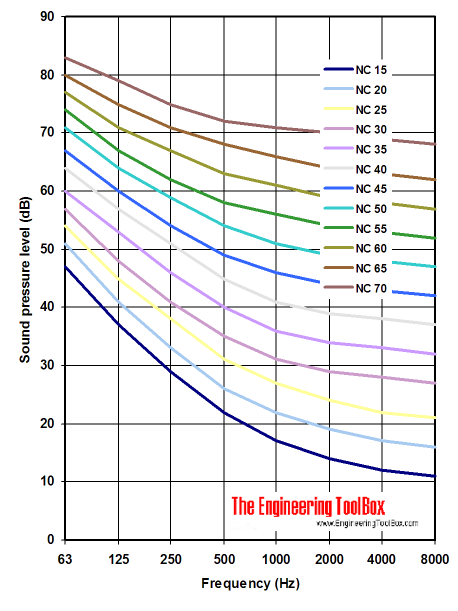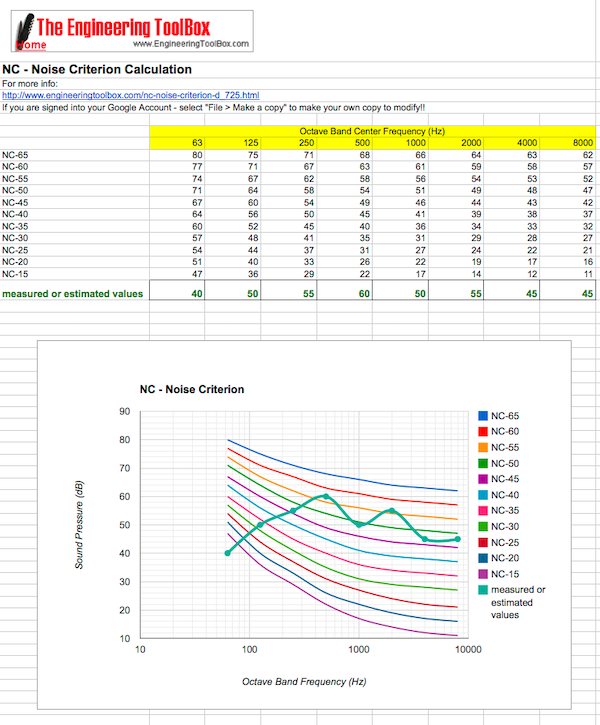NC - the Noise Criterion
Noise Criterion - NC - level is a standard uesd to describe the relative loudness of a space within a range of frequencies.
Noise Criterion - NC - were established in the U.S. to rate indoor noise like noise from air-conditioning equipment and similar. In Europe it is common to use the alternative Noise Rating Curve - NR.
The method is based on a measurement of sound pressure levels and a set of sound pressure criteria curves ranging frequencies from 63 to 8000 Hz - and a tangent rating procedure. The criteria curves defines the limits of the octave band spectra that must not be exceeded to meet the occupants acceptance in the actual spaces.
The NC rating can be determined by plotting the measured sound pressure at each octave band. The noise spectrum is specified as having a NC rating same as the lowest NC curve which is not exceeded by the spectrum.

| Noise Criterion | Octave Band Center Frequency (Hz) | |||||||
|---|---|---|---|---|---|---|---|---|
| 63 | 125 | 250 | 500 | 1000 | 2000 | 4000 | 8000 | |
| Sound Pressure Levels (dB) | ||||||||
| NC-15 | 47 | 36 | 29 | 22 | 17 | 14 | 12 | 11 |
| NC-20 | 51 | 40 | 33 | 26 | 22 | 19 | 17 | 16 |
| NC-25 | 54 | 44 | 37 | 31 | 27 | 24 | 22 | 21 |
| NC-30 | 57 | 48 | 41 | 35 | 31 | 29 | 28 | 27 |
| NC-35 | 60 | 52 | 45 | 40 | 36 | 34 | 33 | 32 |
| NC-40 | 64 | 56 | 50 | 45 | 41 | 39 | 38 | 37 |
| NC-45 | 67 | 60 | 54 | 49 | 46 | 44 | 43 | 42 |
| NC-50 | 71 | 64 | 58 | 54 | 51 | 49 | 48 | 47 |
| NC-55 | 74 | 67 | 62 | 58 | 56 | 54 | 53 | 52 |
| NC-60 | 77 | 71 | 67 | 63 | 61 | 59 | 58 | 57 |
| NC-65 | 80 | 75 | 71 | 68 | 66 | 64 | 63 | 62 |
| NC-70 | 83 | 79 | 75 | 72 | 71 | 70 | 69 | 68 |
Related Mobile Apps from The Engineering ToolBox
- free apps for offline use on mobile devices.
Recommended Noise Criterion - NC
NC rated noise should not exceed the limits listed below:
| Type of Room - Space Type | Recommended NC Level NC Curve | Equivalent Sound Level dBA |
|---|---|---|
| Residences | ||
| Apartment Houses | 25-35 | 35-45 |
| Assembly Halls | 25-30 | 35-40 |
| Churches, Synagogues, Mosques | 30-35 | 40-45 |
| Courtrooms | 30-40 | 40-50 |
| Factories | 40-65 | 50-75 |
| Private Homes, rural and suburban | 20-30 | 30-38 |
| Private Homes, urban | 25-30 | 34-42 |
| Hotels/Motels | ||
| - Individual rooms or suites | 25-35 | 35-45 |
| - Meeting or banquet rooms | 25-35 | 35-45 |
| - Service and Support Areas | 40-45 | 45-50 |
| - Halls, corridors, lobbies | 35-40 | 50-55 |
| Offices | ||
| - Conference rooms | 25-30 | 35-40 |
| - Private | 30-35 | 40-45 |
| - Open-plan areas | 35-40 | 45-50 |
| - Business machines/computers | 40-45 | 50-55 |
| Hospitals and Clinics | ||
| - Private rooms | 25-30 | 35-40 |
| - Operating rooms | 25-30 | 35-40 |
| - Wards | 30-35 | 40-45 |
| - Laboratories | 35-40 | 45-50 |
| - Corridors | 30-35 | 40-45 |
| - Public areas | 35-40 | 45-50 |
| Schools | ||
| - Lecture and classrooms | 25-30 | 35-40 |
| - Open-plan classrooms | 35-40 | 45-50 |
| Movie motion picture theaters | 30-35 | 40-45 |
| Libraries | 35-40 | 40-50 |
| Legitimate theaters | 20-25 | 30-65 |
| Private Residences | 25-35 | 35-45 |
| Restaurants | 40-45 | 50-55 |
| TV Broadcast studies | 15-25 | 25-35 |
| Recording Studios | 15-20 | 25-30 |
| Concert and recital halls | 15-20 | 25-30 |
| Sport Coliseums | 45-55 | 55-65 |
| Sound broadcasting | 15-20 | 25-30 |
Example - Estimate Rated Noise by using the Noise Criterion
Sound pressure levels are measured for different frequencies as:
- 62.5 Hz : 40 dB
- 125 Hz : 50 dB
- 250 Hz : 55 dB
- 500 Hz : 60 dB
- 1000 Hz : 50 dB
- 2000 Hz : 55 dB
- 4000 Hz : 45 dB
- 8000 Hz : 45 dB
The Noise Criterion can be estimated to
NC = 57 dB
as indicated in the spreadsheet diagram below.
NC - Noise Criterion - Interactive Spreadsheet
You can save and modify your own copy (in Google Docs or as a Excel spreadsheet) of the example below.
 NCB Curves
NCB Curves
Balanced Noise Criteria (NCB) curves are used to specify acceptable background noise levels in occupied spaces and include noise from air-conditioning systems and any other ambient noise. They are intended to replace the NC curves.
Related Topics
-
Acoustics
Room acoustics and acoustic properties. decibel A, B and C calculations. Noise Rating (NR) curves. Sound transmission through walls. Calculate sound pressure, sound intensity and sound attenuation.
Related Documents
-
Noise - Acceptable dBA Level
Acceptable noise - dBA - level at typical common locations. -
Noise Criterion (NC) - Free Online Calculator
Calculate Noise Criterion (NC) from octave band pressure levels. -
Noise Criterion vs. Noise Rating and dB(A)
Comparing Noise Criterion (NC, NCB, RNC) to Noise Rating (NR) and dB(A). -
Noise Rating (NR) - Free Online Calculator
An online Noise Rating (NR) calculator. -
NR - the Noise Rating Curve
The Noise Rating (NR) Curve used to determine acceptable indoor environments for hearing preservation, speech communication and annoyance. -
Octave Band Frequencies
The octave and the 1/3 octave band frequencies. -
PNC - the Preferred Noise Criterion
A noise measurement system for continuous or ambient noise in indoor environments. -
Preferred Noise Criterion (PNC) - Calculator
An online Preferred Noise Criterion (PNC) calculator. -
RC - the Room Criteria
The Room Criteria (RC) is used to measure background noise in buildings for frequencies ranging 16 to 4000 Hz. -
Sound - Leq - Equivalent Level
The EPA Equivalent Sound Level - Leq - quantifies the noise environment to a single value of sound level for any desired duration. -
Sound - Ls - Exposure Level
The EPA Sound Exposure Level - Ls - describes the noise from a variable source. -
Sound Intensity, Power and Pressure Levels
Introduction to decibel, sound power, intensity and pressure.




